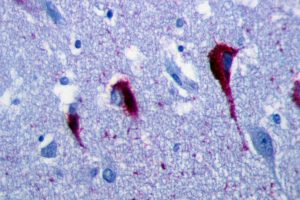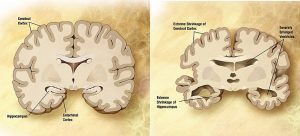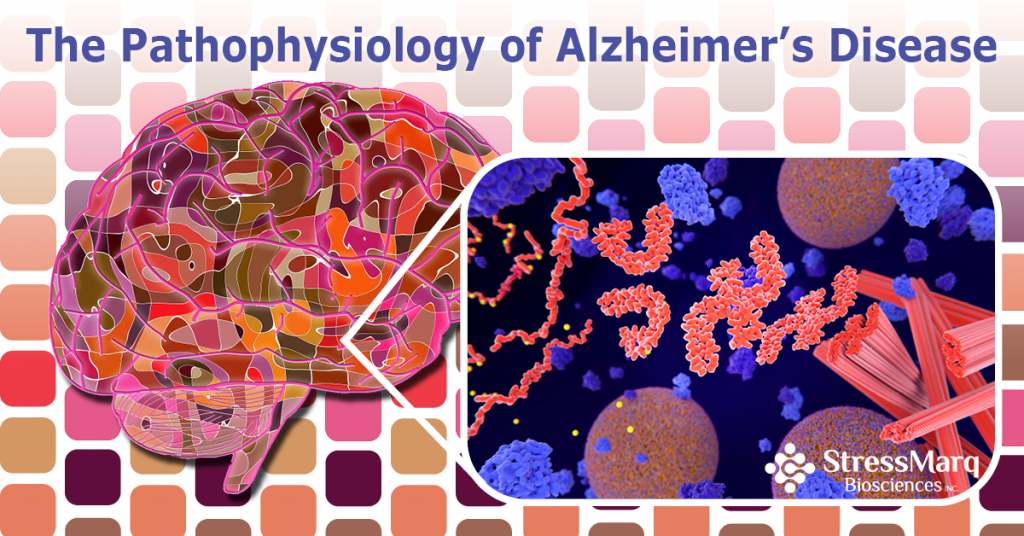The Pathophysiology of Alzheimer’s Disease
Alzheimer’s disease (AD) is one of the fastest growing age-related diseases and research on it has followed suit, making it a focus of many cutting-edge investigations. AD is a very complex, heterogeneous disorder with several features and different subtypes.
What is Alzheimer’s Disease?
AD is a progressive neurodegenerative disease characterized by cognitive and functional decline that leads to death within 3 to 9 years of diagnosis. It is the most common cause of dementia and most people develop symptoms in their mid-60s1.
Familial Alzheimer’s Disease
While it is still unknown what causes AD, several factors are thought to be implicated. Only 5% of AD cases are familial (FAD), caused by inherited genetic mutations. Mutations on the genes APP (Amyloid Precursor Protein), PSEN1 (Presenilin 1) and PSEN2 (Presenilin 2) are responsible for these cases. Interestingly, this type is called early-onset familial Alzheimer’s disease because people tend to show symptoms before the age of 652.
Sporadic Alzheimer’s Disease
The most common form of AD cases is called sporadic AD (SAD). Instead of a clear family link, it is associated with a complex combination of genetic and environmental factors, and aging is the greatest risk factor2. The most common gene associated with late – onset AD is the apolipoprotein (APOE). The allele APOE e4 in particular correlates with higher risk of AD3. Another genetic risk factor that has been linked to SAD is TREM2, a triggering receptor expressed on myeloid cells-2.
Features of Alzheimer’s Disease
Major Hallmarks
In 1906 Dr. Alois Alzheimer, a German physician and psychiatrist, first identified the disease when he observed neuritic plaques and fibrillary tangles in a patient’s brain cells after an autopsy. AD is considered a protein misfolding disorder because of the extracellular deposition of amyloid plaques and the intracellular accumulation of insoluble tau neurofibrillary tangles in the brain4. Amyloid beta plaques and tau tangles are the main pathological hallmarks of Alzheimer’s disease and it is believed that both contribute to AD. They are mainly found in brain areas related to learning, memory and emotions such as the hippocampus, forebrain, amygdala and entorhinal cortex5.
Several hypotheses have tried to explain the causes of AD including abnormal deposit of amyloid-β, tau tangles formation, cholinergic neuron damage, oxidative stress and inflammation6. However the real etiology of the disease remains unknown as AD is considered a multifactorial disorder. This is one reason effective treatments are not yet available.
What are Amyloid Beta Plaques?
Amyloid beta peptides (36-43 amino acids), derived from the amyloid precursor protein (APP), are the main components of amyloid beta plaques in AD brains. APP is a transmembrane protein associated with neuronal development. This protein undergoes proteolysis by the beta- and gamma- secretases and releases the amyloid beta peptides. Mutations in the APP gene as well as the PSEN genes lead to the formation of longer amyloid fragments which clump together into oligomers and fibrils7. Recent studies suggest that amyloid oligomers are the toxic species and not the plaques as they can induce oxidative damage, tau phosphorylation and synaptic dysfunction8. It has also been demonstrated that brain areas with amyloid plaques show reduced synaptic and neuronal damage5,8.

The amyloid precursor protein (APP) is cleaved by the enzymes β-and γ-secretase and produces the insoluble fraction amyloid beta, crucial for the amyloid plaque formation in AD.
What are Neurofibrillary Tangles?
Tau (tubulin-associated unit) is a highly soluble protein of the central nervous system that stabilizes microtubules of healthy neurons. Alzheimer’s disease is considered a tauopathy due to abnormal tau aggregation. In AD, tau becomes hyperphosphorylated which leads to its dissociation from the microtubules, forming neurofibrillary tangles (NFTs) which are deposits of insoluble misfolded and hyperphosphorylated tau. These NFTs can cause neuronal dysfunction and death9.

Neurofibrillary tangles in the Hippocampus of an old person with Alzheimer-related pathology. Patho / CC BY-SA (https://creativecommons.org/licenses/by-sa/3.0)
Other features of Alzheimer’s Disease
Cerebral Atrophy
Cerebral or brain atrophy is characterized by nerve cell death and brain tissue loss. Alzheimer’s disease involves progressive cognitive decline that can be linked to a significant reduction in brain volume. In particular, the hippocampus is the first brain structure to undergo atrophy leading to cognitive impairment and in later stages, memory loss10.
Oxidative Stress
Oxidative stress is caused by an imbalance in the redox state and involves the excessive production of Reactive Oxygen Species (ROS) leading to oxidative damage in cells and organs. Previous studies have shown that AD patients present significant oxidative damage caused by the abnormal accumulation of amyloid beta and the deposition of tau neurofibrillary tangles11.
Neuroinflammation
Neuroinflammation is a chronic inflammation of the central nervous system that is associated with neurodegenerative diseases and triggers abnormal brain functions. In case of neuroinflammation, microglia are activated as an immune response to the amyloid beta plaques12.

Left: normal brain, Right: brain of a person with Alzheimer’s disease.
Alzheimer’s Disease Research
StressMarq offers a wide variety of tools for Alzheimer’s disease research including Amyloid Beta and Tau monomers, oligomers and pre-formed-fibrils. Learn more about different disease models used in AD research.
REFERENCES
- Alzheimer’s disease. Querfurth, H.W. et al . (2010) The New England journal of medicine362(4): 329-44.
- The genetics of Alzheimer disease. Tanzi RE. (2012) Cold Spring Harb Perspect Med. 2(10):a006296.
- Gene dose of apolipoprotein E type 4 allele and the risk of Alzheimer’s disease in late onset families. Corder EH. et al. (1993) Science 261:921–923.
- Role of protein aggregation in mitochondrial dysfunction and neurodegeneration in Alzheimer’s and Parkinson’s diseases. Hashimoto, M. et al. (2003) Neuromol Med4: 21–35.
- Pathways towards and away from Alzheimer’s disease. Mattson, MP. (2004) Nature, 430(7000): 631–639.
- Alzheimer’s disease hypothesis and related therapies. Du X. et al. (2018) Transl Neurodegener. 7:2.
- Amyloid precursor protein processing and Alzheimer’s disease. O’Brien RJ. et al. (2011) Annu Rev Neurosci. 34:185–204.
- The Role of Amyloid-β Oligomers in Toxicity, Propagation, and Immunotherapy. Sengupta U. et al. (2016) EBioMedicine. 6: 42–49.
- Neurofibrillary tangles but not senile plaques parallel duration and severity of Alzheimer’s disease. Arriagada, PV. et al. (1992) Neurology42, 631–639.
- Potential Predictors of Hippocampal Atrophy in Alzheimer’s Disease, Dhikav V. et al. (2011) Drugs Aging 28(1): 1-11.
- Evidence of increased oxidative damage in subjects with mild cognitive impairment, Keller JN. et al. (2005) Neurology 64(7): 1152-1156.
- Neuroinflammation in Alzheimer’s disease. Heneka MT. et al. (2015) Lancet Neurol. 14(4):388–405.


Leave a Reply